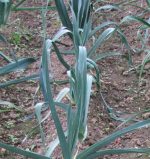 Native to the eastern Mediterranean and Middle East, leek is a biennial and are related to onion, garlic, and daffodil. It grows 2-3′ tall and consists of a bundle of flat folded leaves growing from a tuft of fibrous shallow roots at the base of the stem plate. Growers often heap soil around the plants to produce a white stalk beneath the leaves. If the plants are allowed to grow a 2nd season umbels of white, pink or purple flowers appear. Photo Credit WikimediaThe leek was grown in Mesopotamia and Egypt from the second millennium BC and is still grown in Palestine today. It has a mild flavor and may be eaten raw or cooked. The Hebrew word חציר is used 20 times in the Hebrew bible but is translated as leek only in Numbers 11.5 because of its traditional association with onion and garlic as in this verse. The word actually means grass and is translated elsewhere as any green food such as lettuce, endive or “greens”.
Native to the eastern Mediterranean and Middle East, leek is a biennial and are related to onion, garlic, and daffodil. It grows 2-3′ tall and consists of a bundle of flat folded leaves growing from a tuft of fibrous shallow roots at the base of the stem plate. Growers often heap soil around the plants to produce a white stalk beneath the leaves. If the plants are allowed to grow a 2nd season umbels of white, pink or purple flowers appear. Photo Credit WikimediaThe leek was grown in Mesopotamia and Egypt from the second millennium BC and is still grown in Palestine today. It has a mild flavor and may be eaten raw or cooked. The Hebrew word חציר is used 20 times in the Hebrew bible but is translated as leek only in Numbers 11.5 because of its traditional association with onion and garlic as in this verse. The word actually means grass and is translated elsewhere as any green food such as lettuce, endive or “greens”.
Numbers 11.5 (NIV) As the Israelites wandered in the desert they complained about the lack of foods that they had eaten when living in Egypt.
“We remember the fish we ate in Egypt at no cost—also the cucumbers, melons, leeks, onions and garlic.”
Leeks like full sun and fertile, loose, medium moist, well-drained soil. They are susceptible to slugs, thrips, the leek moth, mildew, and leek rust. Propagation is by seed and seedlings can often be bought at garden centers.
The genus name, Allium, is the classical Latin name for garlic. The specific epithet, porrum, is the classical Latin word for leek.